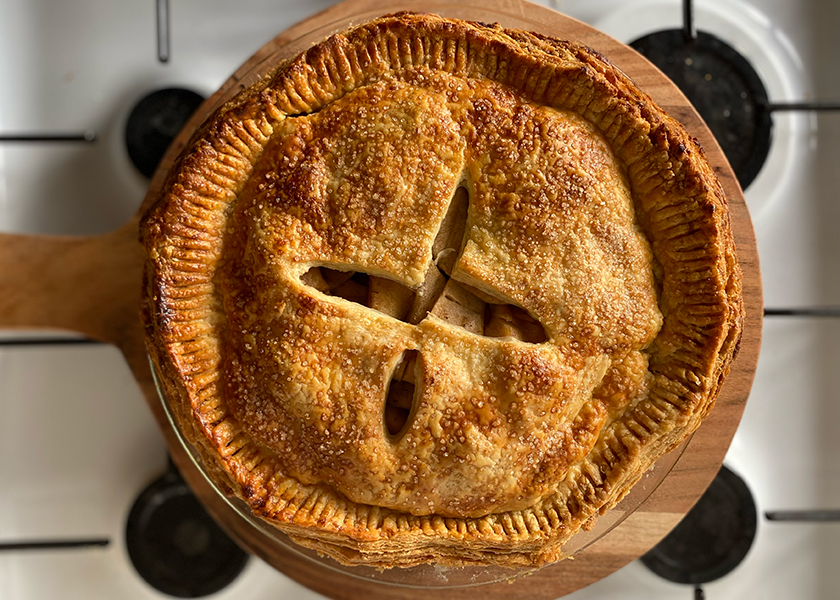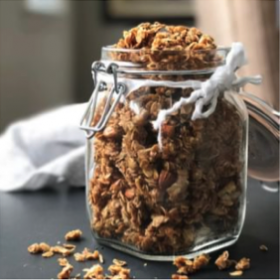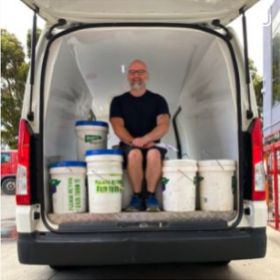Ingredients
For the pastry:
375 g plain flour
2 tsp sugar
1 tsp salt
285g unsalted butter, chilled, cut into 2.5 cm pieces
1 tbsp apple cider vinegar
60 ml iced water, plus more as needed
For the filling:
20g unsalted butter, plus extra for greasing
100g caster sugar
2 large cooking apples (tarter variety such as granny smith), cored, peeled and each cut into 16 wedges
4 eating apples (sweeter variety such as pink lady) , cored, peeled and each cut into 8 wedges
½ tsp ground cinnamon
1/4 tsp allspice
Bringing it together:
1 large free-range egg , beaten with 1 tsp
1-2 tbsp raw sugar
Summary
You mustn’t be put off by the prospect of making pastry. We understand that it can be disconcerting at times, but if you follow the recipe and have pure faith in the power of butter, then we promise there’ll be a flakey crust enveloping your sweet, spiced apple pie when it comes out of the oven. This is a weekend project, but a rewarding one, with an emoji-grade dessert on the other side 🥧
For the pastry:
Too much water is the enemy of a good flaky crust. Most people add more water than needed because they think the dough is too dry or hard to work with, but a dough that has just been mixed will never be easy to work with. That’s why we rest it – to give it a chance to hydrate and relax, becoming easier to roll. So while it’s occasionally necessary to add a tablespoon or two more of water to get the dough feeling good, don’t go overboard!
Whisk 375g flour, 2 tsp sugar and 1tsp salt in a large bowl. Using your hands, smoosh the 285g butter into the flour using your fingertips, creating long, thin flaky bits. When most of the butter is incorporated and there are no large chunks remaining, dump the four mixture onto the cleanest, largest work surface you have.
Combine the 1 tbsp vinegar with the 60ml iced water and drizzle it over the flour. Using the tips of your fingers, run your hands through the mixture. Do this a few more times, until it all starts coming together.
Using the palms of your hands, start kneading the dough, gathering up any dry bits from the bottom and placing them on
the top to be incorporated. You can add 1 tbsp, maybe 2 tbsp, water during this process if you feel the dough really needs it, but it should remain on the drier side; it will hydrate and become more tender as it rests.
When you’ve got a shaggy mass of dough (it will not be smooth and it certainly will not be shiny), knead it one or two more times, then divide it in half. Pat each half into a flat disc, about 2.5 cm thick. Wrap each disc individually and refrigerate for at least 2 hours or up to 4 days*.
Two hours – four days later:
On a lightly floured surface, with a lightly floured rolling pin, roll out one disk of pie dough into a round about 35cm in diameter. You might find the dough is sticking to your work surface, keep the flour handy and dust with extra as necessary. Keeping the dough moving (spinning, flipping) helps ensure it doesn’t stick. Your final shape might have cracks, it might not be perfectly round, that’s totally fine, you’ll be able to patch it up with excess dough later.
Transfer the first round of pastry to a baking paper-lined baking tray and repeat with the remaining disk of dough, making sure you place a piece of baking paper between both rounds so they don’t stick. Pop the baking tray in the fridge while you make the filling.
For the pie filling:
Put the 20g butter and 100g sugar into a large saucepan and, when the butter has melted, add the apples, 1/2 tsp of cinnamon and 1/4 tsp of allspice. Slowly cook for 15 minutes with a lid on, then 5 minutes with the lid off.
Remove apples from the heat and leave them to cool completely before assembling the pie – you can fast-track this process by spreading them in a single layer on a baking tray and putting it outside or in the fridge.
Bringing it together:
Place a large baking tray lined with foil on the middle rack of the oven and preheat to 200°C.
Transfer one round of dough to a 24cm pie plate, letting it slump in the centre with an even distribution of crust around the edges. Using your fingers, encourage the crust to fit snugly against the pie dish. And patch up any holes you may have with excess dough.
Add the filling, letting it sort of mound in the centre (it’ll distribute evenly as it bakes). Brush the edges of the dough with the egg wash. Place the remaining round of dough over the filling and, using your fingers, press the dough together around the edges to seal.
Using a fork dipped in flour, carefully press down around the edge, sealing the pastry. Trim away any excess overhang with scissors**. Make a few slits in the top to allow moisture and steam to escape as the pie bakes. This is a necessary step that allows the filling to thicken properly, as well as ensures a flaky, crunchy crust.
Brush the top with the egg wash and sprinkle with the raw sugar. Place the pie on the preheated tray and bake for 20 minutes. Then reduce heat to 190°C. Continue cooking until the interior is bubbling and the crust is golden brown, about 30-40 minutes more. Remove and allow to cool on a windowsill or kitchen rack for about 2 hours before cutting into the pie – it’s too delicate otherwise!

Hints and Tips
*Pastry dough can be made up to 4 days ahead, wrapped tightly and stored in the refrigerator, or tightly wrapped in a resealable plastic bag and frozen for up to 1 month.
** don’t throw away this excess. Ball it up and freeze it, or roll it out to make mini jam tarts! The pastry won’t be quite as flaky but it’ll still be delicious!


